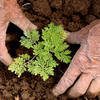You are here
Antifungals and antibiotics have identical resistance mechanisms

On the one hand, there has been a rise in the number of patients infected with Aspergillus fumigatus, a pathogenic micro-fungus found in soil. On the other, hundreds of tulip bulbs were destined to embellish the new terraces of Besançon hospital, in eastern France. Because she had one foot in research, in the Chrono-environment laboratory1, and the other in the clinic, as head of the parasitology-mycology unit at the University hospital, Laurence Millon, with her team, was able to establish the link between the two.
This was in 2019 in Besançon, at a time when the resistance of certain mycoses to antifungal agents was receiving virtually no media coverage. “This subject is still little known, because infections caused by fungi affect fewer people than those triggered by viruses or bacteria,” she says.

In their common forms, these infections may not be particularly severe. In their invasive forms, however, they impact individuals with serious diseases related to the immune system (cancer, AIDS, chronic respiratory disease) or patients who have received bone marrow or organ transplants. The consequences can be dramatic, with the risk of death exceeding 50%!
Increased monitoring
Mycoses resistant to antifungal agents are the subject of increased monitoring. In 2022, the WHO published the first list2 of 19 particularly dangerous fungi (e.g. Cryptococcus neoformans, Candida auris, Aspergillus fumigatus and Candida albicans) – not only because “the incidence and geographical range of fungal diseases are expanding worldwide as a result of global warming and growing international trade”, as the organisation’s report points out, but above all because they are increasingly resistant to treatment.
The same antifungals are used in human and animal health, agriculture and horticulture. As is the case with over-prescribed antibiotics, to which bacteria have become resistant, the massive use of antifungals is leading to a gradual decline in their effectiveness.



For some fifteen years now, Dutch biologists have been reporting in scientific publications a worrying rise in resistance to antifungal drugs in the Netherlands, in particular regarding infections caused by Aspergillus. They established a connection with the large quantities of fungicides spread on flower crops in populated areas.
“This was a wake-up call for us,” explains Millon. “In 2013, at the hospital in Besançon, we isolated a strain of Aspergillus resistant to the main existing treatment, voriconazole, from a farmer patient. We then took samples not only from the land he was cultivating and the dust from his tractor filters, but also from his home, because we know that spores spread over long distances and remain suspended for a very long time in the air, soil and compost. And we did find spores carrying a resistance mutation (TR34) in one of the places visited by this farmer. It was therefore highly likely that they had been inhaled.”
Contaminated sawmills
A few years later, the same team was baffled by the case of another patient, employed in a sawmill. He had suffered facial trauma at work and, although in good health before the accident, had subsequently developed an extremely serious sinus infection that was resistant to treatment. “In sawmills, boards are often soaked in baths filled with azole fungicides to combat wood-rotting fungi, then left outside to dry. This explains why he was contaminated by a resistant strain of Aspergillus at the time of the accident, and why the soils were also heavily contaminated, as shown by the samples we collected from around twenty sawmills using the same practices.”
At Besançon hospital, the contamination of the terraces led to the removal of all the bulbs, which were replaced the following year by organic equivalents, grown without fungicides. As a result, while 69 azole-resistant isolates of Aspergillus fumigatus had been detected in the soil in 2019, samples taken in 2020 using the same procedure showed that the resistance rate had dropped from 71% to less than 3% in one year.
Finding weapons to combat resistance
The “culprit” has therefore been formally identified. But, given that it is illusory to imagine that horticulture will rapidly and drastically reduce the use of fungicides, how can this resistance be combatted?
“Whereas bacteria are prokaryotic organisms, without nuclei, which antibiotics can destroy without harming patients, fungi3, like human beings, are eukaryotes, whose cells have nuclei,” explains Thierry Noël, head of the Candida team in the MFP fundamental microbiology and pathogenicity laboratory4. It is therefore difficult to find treatments that attack fungi without at the same time harming the health of human beings with fungal infections!

This is one of the reasons why there are only four classes of antifungal drugs available for the most serious infections, compared with around ten families of antibiotics. The most common antifungals are treatments known as “azoles”. These block the production of ergosterol, an important component of fungal cell membranes that “is not found in humans, but is equivalent to our cholesterol”, Noël explains.
When azole fungicides are applied in the environment, they favour strains of Aspergillus that are adapted to these azole molecules, through selection pressure. As a result, strains resistant to azole fungicides develop.

“In the Netherlands, we're reaching very high levels of resistance, in the region of 20-30% in patients, whereas in France, we're not exceeding 5 or 6% for the time being,” observes Millon. In recent years, however, these resistant strains have made it necessary to systematically carry out an “antifungiogram”, i.e. a biological analysis to detect a resistant mycosis, and therefore a possible therapeutic failure.
“If the patient is a carrier of such a resistant mycosis, we need to offer them another treatment, effective against all forms of mycosis, but with the risk of serious side-effects.” Given the excessively high levels of resistance, physicians in the Netherlands are already being forced to prescribe this more toxic antifungal as a first-line treatment.
Finding new treatments
Could there be another solution? A few years ago, in Bordeaux (southwestern France), Noël began research into a treatment for Candida responsible for vaginal infections based on immunotherapy, without resorting to antifungals. “The idea is to teach the patient's own immune system to identify infection by this pathogen, and then to defend itself against it,” he explains. “Yet, for the moment, we are only carrying out experiments in mice.”

“In France, an estimated 16,000 people contracted a severe fungal infection between 2012 and 2022,” points out Fanny Lanternier, head of the French National Reference Centre for Invasive Mycoses and Antifungals (CNRMA), which closely monitors the development of these pathologies at France’s Institut Pasteur. Worldwide, they are responsible for 1.6 million deaths every year.
A European research project5 has also just been launched, involving around 20 countries (in Europe, but also Australia, South Africa, Canada, etc.). It should make it possible, in a wide range of geographical areas (including the EU and Africa), to detect the emergence of resistance to dual-use antifungals (human health and agriculture) and, using air sampling monitoring tools, to study more specifically the risk of exposure to Aspergillus fumigatus resistant to antifungals. ♦
- 1. CNRS / Université Marie et Louis Pasteur, Besançon.
- 2. WHO list of 19 fungal pathogens that pose the greatest threat to public health, divided into three categories (critical, high and medium priority): https://www.who.int/publications/i/item/9789240060241
- 3. Organisms in the fungal kingdom are defined by several characteristics, including, but not limited to, the fact that they are eukaryotic organisms. They also lack chlorophyll, feed by absorption and have no leaves, stems or roots, etc.
- 4. CNRS / Université de Bordeaux.
- 5. Bridging the gap between environment and patient; investigating the risk and transmission of antifungal resistance in Aspergillus fumigatus (GAP-AFR): https://www.jpiamr.eu/projects/gap-afr/


















